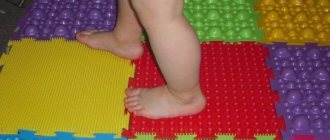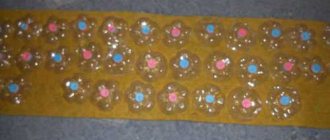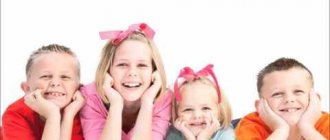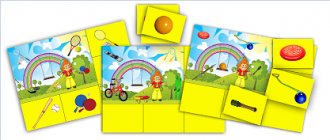“Organization of recreational work during the day with preschool children”
Organization of recreational work during the day
with preschool children
The goal of health work in preschool educational institutions is to preserve and strengthen the physical and mental health of children, improve their physical development, and introduce them to a healthy lifestyle.
Health activities in kindergarten allow the child to cope with the difficulties of getting used to a new environment, allow them to organize the child’s life in a preschool institution in such a way that leads to the most adequate, almost painless adaptation to new conditions, and the formation of a positive attitude towards all types of everyday life.
Wellness activities take an integrated approach and are built on three main areas:
- Creation of a healthy environment for the prevention of various deviations in psychophysical development in children (vision, flat feet, poor posture, articulation apparatus, breathing).
- Formation of a healthy lifestyle for children in kindergarten and at home.
- Development of physical qualities of preschool children.
The deterioration of children's health dictates the need to develop and implement health-improving measures aimed at improving children's health and reducing their morbidity.
Mode
– this is the correct distribution in time and the correct sequence in satisfying the basic physiological needs of the child’s body: sleep, eating, wakefulness. The correct regime ensures a balanced, cheerful state of the child, protects the nervous system from overwork, and creates favorable conditions for the physical and mental development of the child. If this most important condition is not met, deviations in the child’s behavior, whims, increased and decreased excitability, poor sleep, lack of appetite, etc. can be observed.
The daily routine of preschool children is based on the fact that children sleep only once during the day for 2-2.5 hours, the time of active wakefulness is extended to 6-7 hours, and their night sleep is 10 hours.
In a preschool institution, the daily routine is structured in accordance with the age of the children. It is necessary that parents understand the importance of this particular condition for the child’s health. Unfortunately, in many families, especially young ones, the regime is neglected, and this inevitably harms the child.
According to many observations, children attending preschool institutions most often get sick after weekends and holidays. And this happens because the child is not provided with the routine to which he is accustomed, to which he was tuned in in kindergarten: they go to bed later in the evening, daytime naps are canceled, walks are replaced with games at home, and they are allowed to watch TV shows as much as they want.
All this affects the fragile child’s body, the functions of all its organs and systems deteriorate, thereby inevitably weakening the protective mechanisms. The child's preschool regime at home should be a continuation of the kindergarten regime; without this, it is difficult to expect success from hardening.
The system of health-improving measures is reflected in the content of health-improving work with preschool children:
I. Motor activity
- Morning exercises for the overall development of the child are carried out every morning.
- Physical education and health classes – 3 times a week (2 times indoors and 1 time for a walk).
- Active and dynamic games - every day during the day.
- Physical exercises.
- Gymnastics after a nap - every day.
- Preventive gymnastics (prevention of scoliosis and poor posture, prevention of flat feet, eye gymnastics) - daily.
- Breathing exercises - daily.
- Walks - daily.
II. Hygiene and water procedures:
- Washing and washing hands daily.
- Games with water – once a week.
- Compliance with the drinking regime - daily.
- Air recirculation and disinfection – daily.
III. Using the natural environment for hardening activities:
- Ventilation of premises - daily.
- Sleeping with the transom open - every day in the summer.
- Walks in the fresh air - daily.
- Providing light conditions.
IV. Hardening:
- Walking barefoot. The main point of walking barefoot is to harden the skin of the feet to the effects of low temperatures, mainly the floor and earth.
- Rinse your mouth with cool water daily.
- Air baths.
- Reasonable clothing.
V. Balanced meals 5 times a day.
VI. Fortification, including vitamin “C” in the third dish.
VII. Working with parents on children's health issues:
- Individual conversations.
- Consultations.
- Parent meetings.
- Health corners.
- Mobile folders.
Thus, the main thing is to teach children from a very early age to value, protect and strengthen their health. This is a cheerful, active, friendly, inquisitive child. The development of the child’s physical qualities proceeds harmoniously. He is durable, fast enough, agile and strong. The mode of his life activity is carried out in accordance with the individual biorhythmological portrait with an optimal ratio of periods of ups and downs of activity, wakefulness and sleep. He is not afraid of unfavorable weather factors or sudden changes in them, since he is hardened, his thermoregulation system is well trained to multidirectional temperature influences, so he does not know what a cold is. Thanks to a balanced diet, this child does not have excess body weight, he has every opportunity for normal harmonious growth and development. Favorable psychological conditions in the family and in the preschool institution contribute to the strengthening of his mental health. The task of all of us, adults, is to create conditions for raising such children.
Wellness activities card index on the topic
Cycle of health activities
for children of middle preschool age
in a kindergarten setting
The goal of health work in kindergarten and, in particular, in our group is to preserve and strengthen the physical and mental health of children, improve the physical development of each child.
The system of health improvement work in kindergarten includes:
= creating conditions conducive to the favorable development of the body; = organization of rational motor activity of children; = carrying out specific (vaccination) and nonspecific immunoprophylaxis.
To effectively improve the health of children in the group, teachers observe and comply with sanitary and epidemiological norms and rules. The system of physical education and health work includes therapeutic and preventive and physical education and health activities.
Morning exercises /daily/- 7 minutes
- Gymnastics after sleep /daily/- 7 minutes
- Breathing exercises /2 times a week/
- Acupressure
- Air baths /before bedtime, after sleep/
- Physical education classes /3 times a week/ – 20 minutes
- Ventilation of groups, bedrooms / according to schedule /
- Finger gymnastics /3 times a week/
- Water hardening /daily/
- Fortification: juices/fruits/daily/
- Preventive vaccinations / individual vaccination calendar /
- Sun hardening /in summer/
- Prevention of flat feet /daily/
- Prevention of children’s posture /daily/
- Physical education minutes /daily/
- Outdoor games /daily/- 15 minutes (2-4 times a day)
- Walks /daily/
- Working with parents/carrying out health activities at home/
When organizing the physical activity of pupils, group teachers use an individual approach, remembering that physical activity must be adequate to the age and gender of the child, his state of health, level of development and biological maturity. We combine physical activity with generally available hardening procedures. At the same time, we make sure to include elements of breathing exercises in the complex of physical education.
| Physical education and health work (secondary group No. 3) | |
| Morning exercises | -Butsinskaya P.P. complexes No. 1, 2, 3, 4. -Kharchenko A.I. “Heroes of fairy tales” “We are slim”, “A clever squirrel”, etc. |
| Gymnastics after sleep | “Cheerful kitten”, “Walk on the sea”, “Walk in the forest”, “Slightly”, “Cheerful bugs”. |
| Acupressure | “Swan neck”, “Blowing away a leaf”, “Walking on the toes”, “Right nostril, left nostril”, etc. |
| Air baths | |
| Physical education classes | According to the plan, physical hand |
| Finger gymnastics | “Orange”, “Plate for Valerka”, “Snowball”, “Time to go to kindergarten”, etc. Special massage balls. |
| Physical education minutes | “Khomka”, “Pinocchio”, “Wind”, etc. |
| Outdoor games | “Find a Pair”, “Owl”, “Trap”, “Planes”, “Santa Claus”, “Fox and Hares”. According to the education plan - image. work of group No. 3 |
| Walks | According to the plan of educational work of group No. 3 |
| Water hardening | Washing with cool water |
| Walking barefoot before and after sleep | "Health Path"; massage mats. |
| Working with parents (consultations, conversations, moving folders, etc.) |
| “What is hardening”; "Clothes in kindergarten"; “This simple runny nose”; "Children's clothing in winter"; “Cautiously icy conditions”; “Gymnastics for children at home”; “Prevention of ARVI”; “Formation of proper breathing in children”; “Elements of breathing exercises”; “How to equip a sports corner for a child at home”, etc. |
The final result of completing the first annual task in our group was a wall newspaper (with parents) “My sports family” and a collage (with children) “My favorite sport”.
One of the areas of our activity is the formation of children's need for a healthy lifestyle.
Preschoolers should:
- understand the importance of a healthy lifestyle;
- understand the peculiarities of the functioning of the body, the rules for protecting the senses;
- serve yourself, analyze your actions and the actions of other children;
- interact with the environment, understand under what conditions the habitat (home, street) is safe for life;
- learn self-massage techniques;
- learn and understand which habits and why are harmful to health. How to behave correctly in society.
The result of our work: a decrease in morbidity. Such positive dynamics are observed in connection with the implementation of all health-improving activities. We believe that a comprehensive system of physical education and health work helps improve children’s health.
MAGAZINE Preschooler.RF
Organization of physical education and health activities with preschool childrenAuthor: Sviridova Victoria Gennadievna
Abstract: the article reveals the construction of an educational space for the harmonious physical development of preschool children, the formation of interest and value-based attitude towards educational activities, the formation of the foundations of a healthy lifestyle.
“Taking care of health is the most important job of a teacher. Their spiritual life, worldview, mental development, strength of knowledge, and self-confidence depend on the cheerfulness and vigor of children.” V. A. Sukhomlinsky.
Preschool age is decisive in the formation of the foundation of children's health. At the present stage of development of society, the task of educating healthy, harmoniously developed people with high mental and physical performance is being posed in a new way. To successfully solve this problem, it is important, as they say, to “take care of your health from a young age .
Preschool institutions provide opportunities to improve children's health. Throughout the entire period of a child’s stay in kindergarten, his health is protected, his body is strengthened, his level of performance and resistance to various diseases are increased.
Children are preschoolers by nature and very active. Their natural desire for development is manifested in countless movements. Being a biological need of a person, movements serve as a prerequisite for the formation of all systems and functions of the body, enriching them with new sensations, concepts, and ideas.
Teaching children the correct movements is not only necessary, but also necessary. Therefore, one of the main tasks is the proper organization of children’s physical education. Reasonable physical education is the basis for the overall development of a child, as it contributes to his normal growth, strengthening of health and formation of the psyche.
The formation of physical qualities, motor skills and abilities is closely connected with the intellectual and mental development of the child, with the development of moral and volitional personality traits.
The main objectives of physical education:
- protection and promotion of child health, hardening of the body
- achieving full physical development: harmonious physique, according to age, developed functions and adaptive abilities of the body, physical and mental performance
- education of moral and volitional personality traits, activity, independence
- creating conditions for appropriate physical activity of children
- formation of vital types of motor actions: walking, running, jumping, crawling and climbing, throwing, catching and throwing; movements of the arms, legs, torso, head; constructions and reconstructions
- formation of a wide range of game actions
- development of physical (motor) qualities: agility (including coordination abilities), general endurance, speed and strength qualities, as well as the ability to maintain balance
- promoting correct posture and preventing flat feet
- formation of accessible ideas and knowledge about the benefits of physical exercise and games, about basic hygiene requirements and rules
- nurturing interest in active motor activity and the need for it.
To solve these problems, the kindergarten must have all the conditions to ensure a sufficient level of physical activity during exercise and walking: a sports ground on the territory of the kindergarten, various sports equipment, including those made by hand, group sports centers, sports equipment.
All this contributes to the assimilation of the age-specific program, helps to make ECD useful and interesting, provides an optimal amount of physical activity and a high level of physical activity.
The organizational forms of working with children in physical education in kindergarten are:
- educational activities
- physical education and health work during the day
- leisure
- independent motor activity of children
- working with family.
The main type of OA are game situations. In order to develop and maintain children’s interest, it is necessary to use different forms of GCD:
- classical (according to the scheme: introductory-preparatory part, main, final parts)
- gaming (using games: folk outdoor games, relay games, attraction games, etc.)
- training type (walking, running, drills, sports games, climbing exercises, acrobatic elements, ball exercises, etc.)
- plot and complex (united with a certain plot, hiking, orienteering, with speech development, with quizzes, etc.)
- rhythmic gymnastics (consisting of dance movements)
- ECD from the series “Studying your body” (talks about your body, learning self-massage, instilling basic skills in self-care and first aid)
- thematic (with one type of physical exercise)
- control tests (identifying delays in the development of a child’s motor skills and ways to eliminate them).
Physical education and health work includes: morning exercises, outdoor games and physical exercises on walks (morning and evening), a physical education minute.
Through morning exercises, very special tasks are solved, namely: “wake up” the child’s body, set it up in an effective way, diversify but moderately influence the muscular system, activate the activity of the cardiac, respiratory and other body systems, stimulate the work of internal organs and sensory organs, promote the formation of correct posture, good gait, and prevent the occurrence of flat feet.
Morning exercises are also valuable because children develop the habit and need to do physical exercise every day in the morning. In addition, it provides an organized start to the day in kindergarten and makes it possible to switch the pupils’ attention to joint forms of activity.
Outdoor games and physical exercises during walks are carried out both with all children and with small subgroups. It is important that during the day each child takes part in an outdoor game organized by the teacher.
However, in no case should one equate outdoor games and physical exercise with GCD. Their main difference is that the games are played in a more relaxed manner and their duration is shorter. Here, the interests of children are more widely taken into account, and a variety of types and forms of games is provided. Walking games can be organized at different times of the year. If the whole group will participate in the game, it is more advisable to play it at the beginning of the walk. The teacher organizes games with small groups of children and individual ones throughout the walk.
The purpose of physical exercises (to develop speed of movement; to develop dexterity; to develop strength and endurance) should arouse children’s interest in independently searching for various movements, and teach them basic control of their movements. Let the kids just play, and exercises in movements turn into a motor fairy tale, fun fun, casual interesting action with an adult, a peer, or with everyone together.
Physical education minutes (physical education minutes) are carried out on GCD with mental load. They relieve fatigue and activate children's thinking, increasing mental performance.
Physical education sessions can be carried out in the form of general developmental exercises, outdoor games, didactic games with movement, dance movements, performing movements to the text of poems, as well as in the form of any motor action and task, but depending on the type of game situations and program tasks.
Active recreation for preschoolers consists of physical education leisure, physical education holidays and Health Days. All these activities help improve motor skills in children, develop their interest and need for physical exercise, and promote physical education among the population.
Planning of physical education leisure and holidays is carried out taking into account the level of general physical development of children in this group and their motor capabilities.
Teachers plan the event in advance, select games and exercises that correspond to the time of year and the theme so that all students can take an active part in them. Some games and exercises involve all the children, while others involve small groups. It is important to create a general joyful mood so that the children remember the holiday for a long time.
Independent motor activity of preschoolers occurs under the supervision of a teacher. The content and duration of physical exercises and games are determined by the children themselves. The nature of these games depends on the individual data, preparedness, capabilities and interests of the children.
When organizing the physical activity of children, it is important to remember the physiological capabilities and physical health of each child. It is the individual approach that should be most fully and widely used by educators to organize the independent motor activity of children. Playground equipment must be located in such a way that it is accessible to children.
One of the means of increasing motor activity in children’s independent activities is motor improvisation to music. Rhythmic movements, stamping, spinning to the beat of music give the child emotional pleasure. Therefore, we must strive to have music played more often in a preschool institution during children’s leisure time and independent play.
The children's life regimen, as a form of physical education and health work, includes Health Day. It is recommended to conduct it at least once a quarter.
On this day, the pupils' daily routine is filled with active physical activity, independent games, sports competitions, and musical entertainment. In the warm season, children's whole life is taken out into the open air. During the cold season, the stay of preschoolers outdoors is extended if possible.
To carry out successful physical education and health work, the kindergarten must work closely with parents. Effective forms of organizing physical education and health work with parents are:
- joint holding of physical education activities, holidays, health days, competitions
- open days, where parents have the opportunity to attend morning exercises, educational activities, and routine moments
- consultations, conversations, recommendations for parents
- parent meetings, round tables
- demonstration of advanced family education: interviews, exhibitions, meetings with parents, conferences.
It’s good to have a library on physical education for the family in a kindergarten or group: stories, poems on physical education for family reading. Meaningful thematic folders, catchy and memorable materials in parent corners are also important in physical education propaganda. The main thing is that they are not imposed, but arouse interest with their novelty, presented without cliches, edifications or moralizing.
The positive effect of physical culture and health work is possible only if its organization is gradual, systematic and comprehensive.
LIST OF SOURCES AND LITERATURE
- Alyamovskaya, V. G. Prevention of psycho-emotional stress in children by means of physical education. V. G. Alyamovskaya. - Moscow: VLADOS, 2006. - 168 p.
- Bogina, T.L. Protecting the health of children in preschool institutions. Methodical manual / T.L. Goddess. – Moscow: Mosaic – Synthesis, 2005. – 112 p.
- Zaitsev, A.A. Physical education of preschool children: Textbook. allowance / A.A. Zaitsev, E.V. Koneeva, N.K. Poleshchuk and others - Kaliningrad: Kaliningr. univ., 2007. - 71 p.
- Health-saving technologies of education in kindergarten. Ed. T.S. Yakovleva. – Moscow: School press, 2006. – 233 p.
- Zimonina, V.A. Raising a preschool child. Growing up healthy / V.A. Zimonina - Moscow: VLADOS, 2003. - 304 p.
- Makhaneva, M. Healthy child: Recommendations for work in kindergarten and primary school / M. Makhaneva. - Moscow: ARKTI, 2004. - 263 p.
- Morgunova, O.N. Physical education and health work in preschool educational institutions / O.N. Morgunova. – Voronezh: IKMA, 2005 – 127 p.
- Ovchinnikova, T.S. Motor game training for preschoolers / T.S. Ovchinnikova. - St. Petersburg: Peter, 2002. – 176 p.
- Protecting the health of children in preschool institutions / Comp. T.L. Goddess. – Moscow: Mosaic-synthesis, 2006. – 165 p.
- Stepanenkova, E.Ya. Outdoor games as a consequence of the harmonious development of preschoolers / E.Ya. Stepanenkova // Preschool education. – 2005. – No. 12. – P.23–25.
- Chupakha, I.V. Health-saving technologies in the educational process / I.V. Chupakha. – Moscow: Education, 2003 – 143 p.
- Shebeko, V.N. Formation of personal physical culture of preschool children in various types of activities / V.N. Shebeko // Current problems and trends in modern preschool education: collection of articles. scientific Art. / edit. N.S. Starzhinskaya et al.; under general ed. L.N. Voronetskoy, T.V. Pozdeeva. – Minsk: BSPU, 2008. – pp. 243–245
- Shiryaeva, I. Hardening of children / I. Shiryaeva // Child in kindergarten - 2001. - No. 6. - P.26-27.
- Physical education and development of preschool children / Ed. S.O. Filippova. - Moscow: Childhood, 2007. - 322 p.
| Next > |




